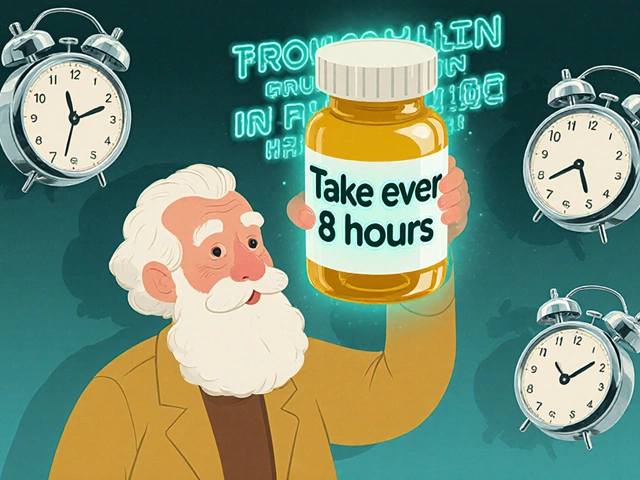Getting stuck with heartburn or acid reflux that just won’t quit? Esomeprazole, often called Nexium, is a pretty common solution. But not everyone gets relief from it, and sometimes there are side effects or drug interactions that make folks want to try something else. Whether it’s not working for you, you’re tired of the price tag, or maybe your doctor thinks another drug will mesh better with your other meds, you’ve got options — real ones.
This isn’t about vague recommendations or one-size-fits-all answers. I’ll run you through six main alternatives to esomeprazole. We’ll talk about how they actually work, what they’re good for, and where they might fall short. I’m also tossing in simple tips that can help you decide which might be right to bring up with your doctor — because honestly, half the battle is just knowing what questions to ask.
- Famotidine (Pepcid)
- Ranitidine (Zantac - Formerly)
- Omeprazole (Prilosec)
- Lansoprazole (Prevacid)
- Pantoprazole (Protonix)
- Rabeprazole (AcipHex)
- Summary Table: Choosing the Right Alternative
Famotidine (Pepcid)
If you’re looking for an Esomeprazole alternative that you can grab right off the pharmacy shelf, Famotidine (Pepcid) stands out. Instead of being a PPI like esomeprazole, it’s in a group called H2 blockers. It works fast by blocking histamine, a chemical that tells your stomach to make acid. Less acid means less burn, plain and simple.
Most folks use famotidine for GERD treatment, peptic ulcers, and quick heartburn relief. It starts kicking in within an hour and gives pretty solid relief if heartburn’s your main problem. It's also handy for those times when you just want something short-term and don’t want to commit to a daily med.
Pros
- Fast-acting—often starts working within 30 to 60 minutes. Perfect if you need quick relief.
- Available over the counter, which means no need to hassle with a prescription for most doses.
- Doesn’t interact with nearly as many medications as PPIs (pretty useful if you’re juggling more than one prescription).
- Lower chance of headaches, diarrhea, or magnesium drops compared to esomeprazole.
Cons
- Doesn’t last as long as esomeprazole, so you may need to take it more than once a day—usually morning and night.
- Not as strong as PPIs for serious, long-running GERD or severe esophagitis.
- Can cause some people to feel dizzy or tired, though this is rare.
- If you switch from a PPI like esomeprazole to famotidine suddenly, your reflux might flare up before things settle down.
Want a wildcard fact? During the COVID-19 pandemic, some hospitals checked out famotidine as a possible treatment for symptoms related to the virus. Results were mixed, but it definitely drew more attention to this old-school heartburn relief staple.
Here’s a quick look at how famotidine compares to esomeprazole for common uses:
| Condition | Famotidine (Pepcid) | Esomeprazole (Nexium) |
|---|---|---|
| Rapid Heartburn Relief | Yes (30-60 min) | No (hours) |
| Chronic GERD Control | Okay for mild-moderate cases | Best for severe/persistent cases |
| Over-the-Counter | Yes | Yes (low dose) |
| Price (OTC) | $ | $$$ |
If convenience, price, or fewer drug struggles are your top priorities, famotidine is definitely worth bringing up with your doctor or pharmacist.
Ranitidine (Zantac - Formerly)
For years, Ranitidine, sold as Zantac, was a go-to choice for people battling GERD and stubborn heartburn. Like famotidine, it worked by blocking histamine receptors in your stomach, dialling back acid fast. Sounds good, right? But here’s the thing—ranitidine isn’t as easy to find anymore, and there’s a big reason why.
Back in 2019 and 2020, the FDA found that some ranitidine products contained small amounts of NDMA, a chemical that could raise cancer risk if taken for a long time. That led to massive recalls and eventually pulled Zantac from shelves in the U.S. and many other countries. If you peek at pharmacies today, you’ll find "Zantac 360°"—but this is actually just famotidine with the old Zantac name.
So, does ranitidine still have a place as an alternative? Not really, unless you’re in a country where the original formula is still stocked and proven safe, which is pretty rare. That said, it’s good to know exactly why it disappeared, especially if you’re browsing old medicine cabinets or talking with someone who used Zantac for decades.
Pros
- Worked quickly for heartburn relief, sometimes within an hour.
- Available in both prescription and over-the-counter forms for decades.
- Generally fewer serious side effects compared to some PPIs.
Cons
- No longer available in its original formula in the U.S. and many other countries after safety concerns.
- Linked to possible cancer risk from NDMA contamination in recalled products.
- Other options like famotidine and omeprazole are now more trusted for GERD treatment and routine acid reflux.
If you ever see someone with older Zantac packs, it’s best to toss them. For folks wanting tried-and-true Esomeprazole alternatives, stick with options that haven’t run into these safety issues.
Omeprazole (Prilosec)
When most people think of over-the-counter treatments for stubborn heartburn relief or GERD treatment, omeprazole (brand name Prilosec) is usually at the top of the list. It’s practically a household name and actually came out before esomeprazole. Both drugs are PPIs (proton pump inhibitors), so they reduce stomach acid by blocking that acid-making enzyme right at the source.
The big difference? Esomeprazole and omeprazole have nearly identical effects, but esomeprazole is just a modified version, supposedly absorbed a bit better. Still, doctors and pharmacists hand out omeprazole like candy for regular folks dealing with frequent acid reflux. It’s one of the most-studied meds out there for long-term control of stomach acid issues.
Here’s what people always want to know: how fast does it work? Omeprazole won’t zap pain instantly like an antacid. It usually takes a day or so to kick in, but results last all day, and even longer with regular use. According to clinical trials, most users get major symptom relief in the first week. That’s why it’s a top option for those who need consistent, ongoing GERD management.
Pros
- Available OTC and by prescription, so it’s easy to get.
- One pill covers 24 hours — super convenient for busy lives.
- Tried and true: Loads of research confirms it works for GERD treatment, ulcers, and more.
- Usually cheaper than esomeprazole, especially generic.
- Less likely to interact dangerously with most common meds compared to some other acid reducers.
Cons
- If you want fast, same-hour heartburn relief, omeprazole won’t cut it — it needs a “loading” phase.
- Some people see side effects like headache, stomach pain, or diarrhea.
- Can mess with absorption of nutrients like magnesium and vitamin B12 if used for months on end.
- May not be as ideal for folks with certain liver issues or people who metabolize medications slowly.
Handy tip: If you start omeprazole, take it about 30 minutes before your first meal, since it works best when those acid pumps are waking up for the day. Don’t double up doses if you forget — just pick up with your next one.
| Typical Dose | Time to Full Effect | FDA Approved Uses |
|---|---|---|
| 20-40 mg per day | 1-4 days | Frequent heartburn, GERD, ulcers, H. pylori combo therapy |
For chronic acid problems, omeprazole almost always makes the short list of alternatives to esomeprazole. Lots of people switch between the two and never notice a difference — except maybe in what they pay out of pocket.

Lansoprazole (Prevacid)
Let’s talk about Lansoprazole, which might sound familiar if you’ve heard of the brand Prevacid. Like Esomeprazole, it’s a proton pump inhibitor—meaning it gets down to business by blocking acid at the source: your stomach’s acid pumps. Doctors prescribe it for GERD treatment, stomach ulcers, and sometimes for long-term heartburn relief if basic stuff like famotidine or antacids aren’t doing the trick.
What sets lansoprazole apart is how quickly it starts working. You can snag it both by prescription and over-the-counter, which is handy if you want to try it without committing to a doctor’s visit right away. In the U.S., Prevacid 24HR has been available OTC since 2009—so it’s been around a while and has a track record behind it.
Pros
- Kicks in fast—some folks feel relief within the first day.
- Good for both short bursts (like a two-week course) and longer-term plans if needed.
- Shown in real-world studies to be about as effective as Ever heard of Prilosec?—same ballpark, so you aren’t missing out on power if you swap.
- Available OTC and by prescription, so you’ve got options if your insurance stinks or you’re traveling.
Cons
- You still need to take it on an empty stomach, which is a pain if you like breakfast right away.
- Because it’s a PPI, it takes a bit longer for full effect compared to H2 blockers—it’s not instant.
- Long-term use can lead to low magnesium or vitamin B12 levels, especially if you already have diet issues.
- Serious side effects are rare, but there’s a known risk for a higher chance of certain gut infections with chronic use.
Doctors often rotate between Lansoprazole, Esomeprazole, or Omeprazole depending on insurance, how your body reacts, or just personal preference. Don’t be surprised if your pharmacy swaps it out unless you ask for a specific one. Heads up: if you take other meds, especially blood thinners or certain antibiotics, let your pharmacist know. It never hurts to check for interactions.
| Lansoprazole | Esomeprazole | |
|---|---|---|
| Brand Names | Prevacid, Prevacid 24HR | Nexium |
| Onset | Within 1–2 hours | Within 1–2 hours |
| OTC Available? | Yes | Yes |
| Prescription Option? | Yes | Yes |
| Main Uses | GERD, ulcers | GERD, ulcers |
If you want an effective alternative without starting from scratch or dealing with extra hoops, Lansoprazole is worth bringing up at your next visit. And if you’re after something you can grab off the shelf, Prevacid 24HR makes it easy.
Pantoprazole (Protonix)
If you’ve bounced around on GERD treatment meds, there’s a good chance your doctor has mentioned pantoprazole, also known by the brand name Protonix. It’s part of the same family as esomeprazole — the PPI (proton pump inhibitor) family. Like esomeprazole, pantoprazole lowers stomach acid by blocking the "pumps" that produce it. This makes it a steady option for long-haul acid issues, including chronic heartburn, ulcers, and reflux that just won’t quit.
Pantoprazole doesn’t work instantly, so don’t expect fast relief like you might get from Pepcid. Usually, it takes a day or two before most folks notice a real difference. The upside? It gives consistent acid control if you stick with it, which is clutch for things like healing an inflamed esophagus or managing tough GERD.
You can take pantoprazole with or without food, which makes it a practical choice for most people’s routines. Plus, it’s less likely to tangle with certain drugs, especially some of the blood thinners or antidepressants where esomeprazole can cause issues. This makes it a safer swap for people juggling multiple prescriptions.
Pros
- Easy once-a-day dose for most cases, keeps things simple.
- Tends to have fewer drug interactions than some other PPIs (like omeprazole and esomeprazole).
- Available as a generic, so it’s often cheaper than branded options.
- Effective for tough, long-term acid reflux and serious conditions like erosive esophagitis.
- Doesn’t interact much with clopidogrel (Plavix), a blood thinner — this is important if you’re taking both.
Cons
- Works slower than H2 blockers (like famotidine) for immediate relief — might take 1-4 days for full effect.
- Could cause vitamin B12 deficiency if used for years. (This happens with most PPIs — routine blood tests can help stay ahead of it.)
- Possible long-term risks, such as bone fractures and gut infections like C. diff, if you’re on it for ages.
- If you stop suddenly after using it for a while, you might get rebound acid (your stomach swings back the other way and actually makes more acid for a bit).
Here’s a quick comparison of basic pantoprazole details so you can size it up against other options more easily:
| Feature | Pantoprazole | Esomeprazole |
|---|---|---|
| Typical Dose | 40mg once daily | 20-40mg once daily |
| Generic Available | Yes | Yes |
| Interactions with Plavix | Minimal | Possible |
| Onset for Acid Relief | 1-4 days | 1-4 days |
| Usage | GERD, erosive esophagitis, ulcers | GERD, erosive esophagitis, ulcers |
The bottom line? Pantoprazole is a solid, practical alternative to esomeprazole for steady acid reduction. If your doctor says you need to switch because of side effects, cost, or drug interactions, this could be the move. Just remember — always check in before changing meds, and ask about any long-term risks if you stay on it for a while.
Rabeprazole (AcipHex)
Rabeprazole, often sold under the brand name AcipHex, is another member of the PPI family—just like Esomeprazole. So, it works by blocking the tiny pumps in your stomach that squirt out acid. This makes it pretty effective at handling tough cases of GERD, healing erosive esophagitis, and even helping out with conditions like Zollinger-Ellison syndrome, where your stomach goes wild with acid production.
A cool thing about rabeprazole is that it tends to kick in pretty fast, sometimes within an hour. It’s usually taken once a day, which is super convenient if you’re not a fan of popping pills all the time. Also, studies have shown its effectiveness in healing the esophagus is on par with other PPIs, but some folks say it causes less stomach upset or headaches. If you can’t tolerate other PPIs, this could be the one to ask your doctor about.
Pros
- Strong option for heartburn relief and acid suppression—often matches or beats other PPIs.
- Usually taken once per day, low hassle.
- Starts working in about an hour for some people, so you don’t have to wait all day for relief.
- May cause fewer headaches and less stomach upset compared to other PPIs.
- Helps heal damaged tissue from acid reflux, not just control symptoms.
Cons
- Only available by prescription in the U.S.—so not a grab-and-go at the pharmacy.
- Long-term use (like all PPIs) can boost your risk for low magnesium, vitamin B12 issues, or bone thinning.
- Might be pricey depending on your insurance; generics are around but cost varies a lot.
- Can interact with some meds—it's smart to double-check with your doctor or pharmacist.
Fun fact: A 2023 study found rabeprazole healed esophagitis in about 89% of patients after 8 weeks, which is right up there with esomeprazole and the rest of the PPI crowd. Bottom line? If you’re shopping for esomeprazole alternatives, rabeprazole could be worth putting on your list—especially if you want a powerful acid blocker that doesn’t need to be taken more than once a day.

Summary Table: Choosing the Right Alternative
There isn’t a single best option when it comes to Esomeprazole alternatives for GERD treatment or heartburn relief. It really depends on your symptoms, other meds you’re on, and how your body reacts. Some people just want something for the occasional spicy-meal regret; others need daily help for chronic reflux. Here’s a side-by-side point of how these meds stack up – it’s basically what your doc is balancing when they make suggestions.
First, here’s a quick comparison table to make things straightforward.
| Drug Name | Type | How Fast? | OTC or Rx? | Best For | Main Drawbacks |
|---|---|---|---|---|---|
| Famotidine (Pepcid) | H2 Blocker | 30-60 min | Both | Quick, short-term heartburn relief | Less strong for chronic severe GERD |
| Ranitidine (Zantac) | H2 Blocker | 30-60 min | Was OTC/Rx (No longer on market) | Mild reflux (not available due to recalls) | Pulled for impurity concerns |
| Omeprazole (Prilosec) | PPI | 1-4 days for max effect | Both | Chronic GERD, ulcers | Needs time, some drug interactions |
| Lansoprazole (Prevacid) | PPI | 1-4 days | Both | Chronic GERD, ulcers | Shouldn't be taken with some meds |
| Pantoprazole (Protonix) | PPI | 1-4 days | Rx | GERD with lots of drug interactions | Prescription only, not as fast as H2s |
| Rabeprazole (AcipHex) | PPI | 1-4 days | Rx | Chronic and tough GERD | Prescription only, insurance questions |
Keep a few key points in mind when picking between these Esomeprazole alternatives:
- H2 blockers like famotidine offer faster relief for on-the-spot symptoms but might not cut it for tough, daily symptoms.
- PPIs (like omeprazole, lansoprazole, pantoprazole, rabeprazole) take a few days for full effect but are better for healing the gut if you’ve got more than just mild heartburn. They’re the go-to for doctors treating ulcers or serious GERD.
- Some folks build a tolerance to H2 blockers if they take them daily, which is why docs usually suggest using them as needed.
- It’s best not to switch or stop your meds without talking to your doctor first. Sometimes, the wrong combo can cause rebound heartburn or mess with other prescriptions.
A quick pro tip: if OTC meds aren’t helping after two weeks, it’s a good signal to get checked for something more serious. Your stomach usually tells the truth—trust those symptoms.






Bonnie Lin
April 18, 2025 AT 17:07If you’re looking for a quick over‑the‑counter fix, famotidine is a solid starter-fast acting and easy on the wallet.
sara fanisha
April 23, 2025 AT 08:13Love that you broke down the pros and cons! It really helps to see which option matches your lifestyle, especially when you’re juggling a busy schedule.
Tristram Torres
April 27, 2025 AT 23:20Honestly, most people just pick the cheapest pill without checking the interaction list. That can backfire big time.
Jinny Shin
May 2, 2025 AT 14:27Behold, the grand tapestry of acid‑suppression marvels, each more illustrious than the last-yet we mere mortals must choose wisely.
deepak tanwar
May 7, 2025 AT 05:33While the article paints PPIs as the gold standard, one must not ignore the emerging data on long‑term microbiome disturbances.
Abhishek Kumar
May 11, 2025 AT 20:40Seems like a lot of info, but at the end of the day, you still need a prescription for half of these.
hema khatri
May 16, 2025 AT 11:47India has its own herbal remedies!!! They work just as well-no need to rely on foreign meds!!!
Jennell Vandermolen
May 21, 2025 AT 02:53Great summary! For anyone unsure, start with a short trial of famotidine and see how you feel before moving to a prescription PPI.
Mike Peuerböck
May 25, 2025 AT 18:00Consider insurance formularies when selecting a PPI.
Simon Waters
May 30, 2025 AT 09:07Some pharma studies on PPIs are funded by the manufacturers themselves-always double‑check the source.
Vikas Kumar
June 4, 2025 AT 00:13Why trust a Western brand when local alternatives have centuries of use?
Celeste Flynn
June 8, 2025 AT 15:20When evaluating alternatives to esomeprazole, it helps to look at both pharmacodynamics and patient‑specific factors.
First, H2 blockers such as famotidine act quickly, usually within 30‑60 minutes, making them ideal for sporadic heartburn episodes.
Second, PPIs like omeprazole, lansoprazole, pantoprazole, and rabeprazole require a loading period of 1‑4 days to achieve maximal acid suppression.
Third, the long‑term safety profile of PPIs has been under scrutiny for potential nutrient malabsorption, bone density loss, and increased infection risk.
Fourth, drug‑drug interactions differ: famotidine has fewer known interactions, whereas PPIs can affect the metabolism of clopidogrel and certain antivirals.
Fifth, cost considerations matter-generic famotidine and omeprazole are usually inexpensive, while newer PPIs may be pricier.
Sixth, patient adherence improves when dosing regimens are simple; a once‑daily PPI taken before breakfast is convenient for many.
Seventh, individual response varies; some patients report adequate relief with H2 blockers, while others need the stronger acid control of a PPI.
Eighth, for patients with severe erosive esophagitis, PPIs remain first‑line because they promote mucosal healing more effectively.
Ninth, insurance formularies often favor certain generic PPIs, so checking coverage can prevent unexpected out‑of‑pocket costs.
Tenth, lifestyle modifications-diet, weight management, and avoiding late‑night meals-complement any medication choice.
Eleventh, if symptoms persist despite optimal therapy, endoscopic evaluation should be considered to rule out complications such as Barrett’s esophagus.
Twelfth, the choice of alternative should be individualized after a thorough discussion with a healthcare provider.
Thirteenth, some patients benefit from rotating between an H2 blocker for occasional flare‑ups and a PPI for chronic control.
Fourteenth, keep a symptom diary to track which medication provides the best relief with the fewest side effects.
Fifteenth, always taper off PPIs rather than stopping abruptly to avoid rebound acid hypersecretion.
Finally, informed shared decision‑making leads to better outcomes and higher patient satisfaction.
Shan Reddy
June 13, 2025 AT 06:27Just a heads‑up: taking PPIs on an empty stomach maximizes absorption, so plan your dose before breakfast.
CASEY PERRY
June 17, 2025 AT 21:33The pharmacokinetic profile of omeprazole demonstrates a delayed Tmax, necessitating a loading phase for optimal acid suppression.
Naomi Shimberg
June 22, 2025 AT 12:40It is worth noting that the categorical exclusion of ranitidine from the market may have inadvertently narrowed therapeutic options for patients with specific contraindications.
kenny lastimosa
June 27, 2025 AT 03:47Perhaps the quest for the perfect antacid mirrors our broader search for equilibrium in an ever‑changing world.
Heather ehlschide
July 1, 2025 AT 18:53If symptoms persist beyond two weeks of OTC therapy, consider endoscopic evaluation to rule out Barrett’s esophagus.
Kajal Gupta
July 6, 2025 AT 10:00Honestly, the choice feels like picking a flavor of ice‑cream-pick what tastes good to you, but don’t overindulge!
Zachary Blackwell
July 11, 2025 AT 01:07While you point out the cheap‑pill trap, remember that many generic brands are produced under strict FDA oversight-still, a healthy dose of skepticism never hurts.